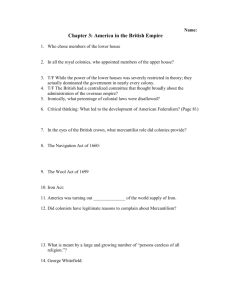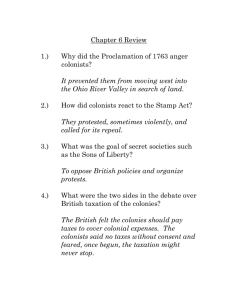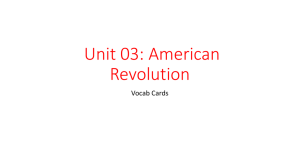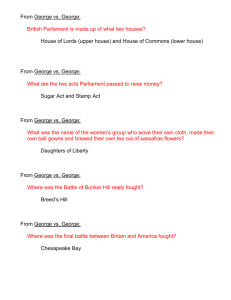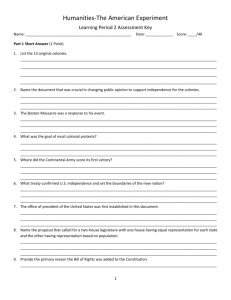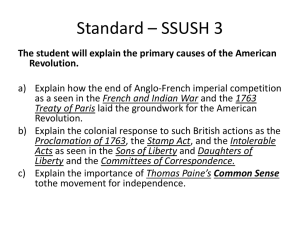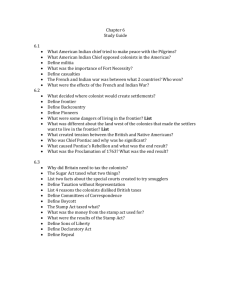The Road Towards American Revolution and Independence (1750
advertisement
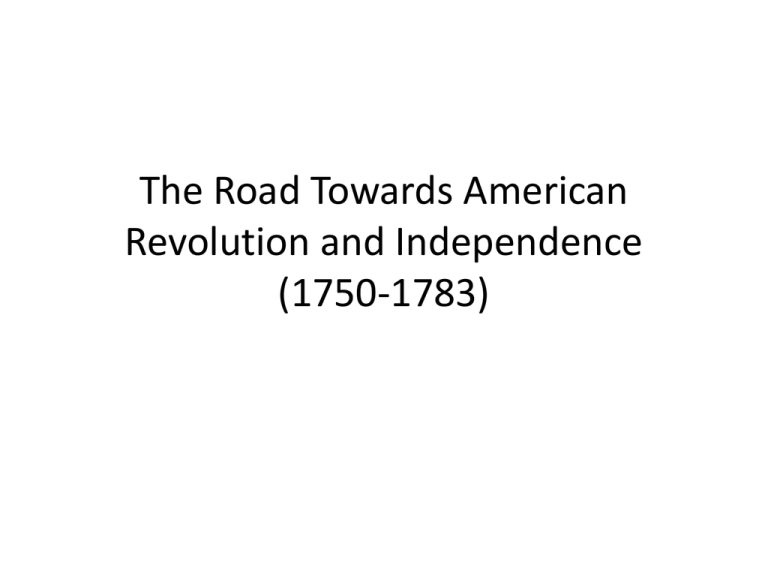
The Road Towards American Revolution and Independence (1750-1783) Themes • Background to the French and Indian War • Acts passed by Parliament and colonial responses • Important events and battles of the American Revolution Years of Warfare Outside of Colonies • King William’s War (1689-1697) • Queen Anne’s War (1702-1713) • King George’s War (1744-1748) • French/Indian War (1754-1763) *Involved England fighting both France and Spain European Occupation of North America (1750) France • Jacques Cartier in 1530s explored east coast of Canada • Sailed up the St. Lawrence River to what is now Montreal France (Samuel de Champlain) • Established Quebec in 1608 • French specialized in fur trade • Helped establish alliance with Huron (Native tribe) • Considered by many to be the “Father” of New France French Explorers • Robert Cavelier de La Salle • Explored the entire length of the Mississippi and stopped in New Orleans • Named the region he explored: Louisiana French Explorers • Antoine Cadillac • A soldier/fur trader who expanded trade • Founded Fort Detroit (1701) French Explorers • It was because of men like La Salle and Cadillac that enhanced claims to the interior of North America Selection Population of North America • 1700 - French: 15,000 - English: 250,000 • 1750 - French: 60,000 - English 1,170,000 French/Indian War (1754-1763) • French and Indian allies vs. British and Indian allies • Called the Seven Years War by Europeans - Fighting in Europe began in 1756; a peace ended the war in 1763 French/Indian War (1754-1763) • French began to expand their borders into the Spanish Empire and colonies of England • 1750- French pressing into Ohio River Valley at the same time the colonies were • 1754- French construct a series of military fortifications along the Appalachian Mts – From Virginia to Great Lakes French/Indian War (1754-1763) • First battle – Fort Duquesne - located near three rivers in modern day Pittsburg - If one could control the rivers, they can control the entire Ohio River Valley • Colonists, French, members of the Iroquois Confederacy, and Indians already living in the area had claims to the land • Area was rich with hunting lands and soil • Colony of Virginia is the 1st to respond French/Indian War (1754-1763) • George Washington, officer from Virginia, was sent to force the French to surrender at Ft. Duquesne • Washington surrendered on July 4, 1754 • With the loss Benjamin Franklin issued the Albany Plan of Union on July 10, 1754 – Plan was to form a centralized government in the colonies to fight back French – The plan was not carried out but important; first attempt to unify colonies • In 1755 the British attacked again under General Braddock; over 2k soldiers (British and colonists) • British forces were defeated and Braddock was killed French/Indian War (1754-1763) • First few years of the war was very harsh for British forces • Fortunes changed for the British as the war continued • French fell at Louisburg in 1758 - gave British control of the Gulf of St. Lawrence - was very difficult for French to send supplies through Canada Battle of Louisburg (1758) French/Indian War (1754-1763) • Quebec fell in 1759 following an attack led by James Wolfe • French victory in North America now seemed impossible • Fighting continued all around the world until 1763 when a peace treaty was signed to end the war French/Indian War (British Victory ) • The French were outnumbered in North America dramatically • Changing alliances with Native Americans also hurt the French • For years Native Americans played Europeans off against one another to their advantage • Despite relative peace among the Natives and due to the fur trade, Native Americans strategically sided with the one who they believed would be victorious French/Indian War (Result) • Treaty of Paris of 1763 -France lost a majority of its overseas empire • Spain gained control of Louisiana • Britain became the dominant power in North America • Native Americans lost ability to played Europeans off against one another • Canada was now under British rule French/Indian War (Result) • Problems resulting from Seven Years War 1. Treasury dwindles to nothing 2. England was bankrupt 3. How do we control a global empire ? English and American Tension • In 1763, Americans were tremendously patriotic and loyal subjects, but tension developed • Britain accumulated a HUGE national debt as a result of the French and Indian War Grenville Plan • In 1763, Lord Grenville becomes new Prime Minister; in charge of solving debt • Proclamation Act of 1763: Prohibited colonial settlement west of Appalachian Mountains - land was reserved for merchants to make money; not colonists Currency Act of 1764: All debts must be paid in gold or silver. Outlaws use of paper money • Revenue Act (Sugar Act) of 1765: Tax on all sugar products (Rum) Proclamation Line of 1763 Stamp Act (1765) • All legal documents had to be printed on paper stamped with the seal of the government • Published items, such as newspapers, also had to be printed on “stamped” paper • Violators were not allowed a trial by jury; judges ruled on their innocence or guilt Stamp Act (Reaction) • Boston crowds destroyed watermarked paper to be used as stamps • Parliament responds, people in England already paid a similar tax • Colonists: This was a direct tax, which undermined local Assemblies. Stamp Act (Reaction) • Patrick Henry and others opposed the Stamp Act • Stamp Act Congress(1765): Delegates from nine colonies met in New York *One of the first attempts the colonies made to work together* • Delegates agreed Parliament had no right to issue taxes such as the Stamp Act Stamp Act (Reaction) • Stamp distributers were threatened with violence throughout the colonies; many resigned their commissions • Samuel Adams led Boston’s Sons of Liberty who would attack and use fear tactics against tax collectors Repeal of Stamp Act • Benjamin Franklin arrives in England with the Declaration of Rights (List of Grievances) - England had no idea about protests until Franklin showed up • On the eve of the Stamp Act being passed several colonial merchants threatened to boycott British products, potentially hurting Britain’s economy • Parliament fires Grenville and is replaced by Lord Prime Minister Rockingham Colony and Britain (1765-1767) • Peace has been restored to the colonies • 1767 – PM Rockingham dies and is replaced by William Pitt • William Pitt dies; Prime Minister William Townshend is given the position Minister of Treasury Townshend Duties • After the repeal of the Stamp Act, Britain was still in debt • In 1768 Parliament passed the Townshend Plan - Taxed glass, lead, paint, paper, and tea imported from England to the colonies • Goal: Generate revenue to pay salaries of colonial Governors • This act threatened elected assemblies because colonists previously had control of Governors’ salaries John Hancock • May 9th 1768 (Boston) • British customs official checks the cargo on a boat belonging to John Hancock; richest man in Boston • The boat is carrying crates of imported wine and don’t want to pay taxes • One of the first signs of rebellion in Massachusetts against taxes by a king 3,000 miles away • British seize ship and arrest men; riots begin • “We have a natural resentment towards government which is how we were born. We are born to rebel.” – Aaron Sorkin Townshend Duties: Repealed • Boycotts of British goods were reinstated; Parliament later repealed duties on most items • Taxes on tea remained; smuggling tea became widespread • 4,000 British troops were sent to Boston to restore law and order • 1 redcoat for every 4 citizens • Boston under military rule English and American Tension (Boston Massacre) • Boston’s residents hated British soldiers • In March 1770 a crowd of angry Boston citizens marched on a British tax office • An angry mob vs 8 redcoats (with orders not to fire) • Someone in the crowd threw a snowball which was actually a brick or stone • After a British officer was hit shots were fired which resulted in the Boston Massacre • Result: 11 colonists wounded; 5 dead The Bloody Massacre by Paul Revere Tensions Continues • Tensions remained high following Boston Massacre • The colonists that died were now seen as martyrs (people who died for a “cause”) • Committees of Correspondence were formed - Information was exchanged and opposition to British policies was coordinated - All colonies participated by 1774 except Pennsylvania Tensions Continues • In order to show England that the colonies had a stable government, the soldiers who fired upon the colonists were to be tried in a colonial court • During the trial the colonists split into Radicals and Moderates • Radicals – wanted independence from England (Samuel Adams) • Moderates – wanted diplomacy (Ben Franklin) • John Adams wins the case; Soldiers innocent English and American Tension (Boston Tea Party) • Parliament passed the Tea Act (1773): - Established tax on tea to raise revenue - Bailed out East India Company - Gave EIC a monopoly on Tea • Son’s of Liberty responded with Boston Tea Party Tensions Continues • Direct response to the Boston Tea Party • Intolerable Acts: 1. Boston Port Act - Closed port in 1774 and made Massachusetts less democratic 2. Quartering Act – soldiers have the right to stay in your house 3. Quebec Act – Allows French in Canada to govern themselves as long as they remain loyal to England Colonists Response • Colonial Response: 1st Continental Congress(1774) All colonies sent representatives except Georgia • Delegates agreed to stop sending goods to Britain and boycott all British products Colonial Resistance (Women) • Women were involved in anti-government protests • Daughters of Liberty supported boycotts • Tried to end dependence on imported cloth The War Begins • Battle of Lexington and Concord 1775 • Goal: Seize colonial military supplies • Paul Revere and William Dawes warned of an attack • Lexington: Eight minutemen died • British moved on to Concord • Concord: About 300 British casualties • British now forced to retreat back to Boston Colonial Ties • Hostilities had begun, but many still found it hard to break with the home country of England • 1/3 – Patriots • 1/3 – Neutral • 1/3 – Loyalists Common Sense • Thomas Paine • Arrived in the colonies two years prior to the American Revolution • Influenced the public to rebel against the king • “Common Sense” - All monarchies are corrupt and evil - Americans should establish a Republic where power came from the people It was simple “common sense” that Americans should break with England The Battle of Bunker Hill, 1775 • Out of the Boston Harbor, British troops attack Bunker Hill (Breed’s Hill) to engage the Continental forces • The British drove the Americans from the Hill but with heavy losses • While the Americans lost, it was seen as a battle cry for the rest of the colonies to join the cause Declaring Independence • 2nd Continental Congress – considered a proposal calling for independence • Thomas Jefferson was the primary author • July 4th, 1776 Congress approved the Declaration of Independence • The Articles of Confederation would request the colonies to levy taxes in order to pay for necessities (Ex. Continental Army) • American Revolution had “officially” begun - 13 Colonies vs. British Signers of the Declaration of Independence • Known Masons (8): Benjamin Franklin, John Hancock, Joseph Hewes, William Hooper, Robert Treat Payne, Richard Stockton, George Walton, William Whipple • Evidence of Membership/Affiliations (7): Elbridge Berry, Lyman Hall, Thomas Jefferson, Thomas Nelson Jr., John Penn, George Read, Roger Sherman • Summary: 15 of 56 signers were Freemasons or probable Freemasons The British • King George III • British Army outnumbered colonists by ration of about 3 to 1 • Strong navy and professional army • Hired mercenaries • Loyalists: Colonists opposed to Independence - Strongest in New York and New Jersey The Americans • George Washington – leader of the Continental Army • Benjamin Franklin – overseas fighting for foreign aid • Colonists fought for an noble cause: Independence • Colonists were plagued by disunity, economic difficulties, and supplies • Positive: Fought a defensive war, unpopular among some in England American Revolution (The War in the North, 1775-1778) • Americans were forced to retreat from New York - about ¼ of his men were captured or killed Washington at Valley Forge (1777-78) • After spending the summer fighting the British and gaining victories (Battle of Brandywine & Battle of Germantown) the British still took Philadelphia • Washington would camp at Valley Forge to keep an eye on General Howe’s army in Philadelphia • Washington and his men suffered from inadequate food, supplies, firewood, and shelter during the winter American Victories • Washington’s surprise attack and victory at Trenton (1776) and Princeton (1777) • Both these victories boosted the psychological moral of troops in the north into thinking that they can beat a well trained army Battle of Saratoga • General Horatio Gates met General John Burgoyne’s Army in northern New York • Gates would eventually defeat Burgoyne and capture the main British force attacking from the north • Fall of 1777- Victory at Saratoga led to French recognition of United States; the subsequent alliance with France became a key factor for the Americans American Revolution (The War in the North, 1775-1778) American Revolution (The West and South) • Campaigns in the wilderness were very small • Mohawk Chief Joseph Brant led many Indians into battle in Pennsylvania and New York • This led to the collapse of the Iroquois Confederacy • Brant fought against the colonists because he believed the British would seize the colonists from expanding west American Revolution (The West and South) • With the lose at Saratoga the British focused their attention on the south • General Cornwallis heads the British Empire in the south • British succeeded with attacks in Georgia and S. Carolina (1778-79) Battle of Camden, 1780 • General Horatio Gates was given the task of to clear the British from the Carolinas • Gates charged against Cornwallis with more than half of his force being militia • The American forces lost nearly 1,000 men and another 1,000 captured • One of the most disastrous battles of the Revolution War in the South • With the defeat of Gates, General Nathaniel Greene assumed command of southern campaign • Greene would assume control of the southern army and would fight a defensive battle to keep Cornwallis in the south • With Cornwallis constantly chasing Greene, Cornwallis will soon find himself trapped at Yorktown American Revolution (Yorktown 1781) • Cornwallis was trapped between Washington’s forces and French navy • Fighting continued for over a year • Victory led to peace negotiations • Treaty of Paris of 1783: 13 colonies are granted Independence Treaty of Paris (1783) • Chief American negotiators: Ben Franklin, John Adams, and John Jay • Franklin was very popular among the French Treaty of Paris (1783) 1. British recognized independence of United States 2. U.S. territory extended from Florida to the Great Lakes and Mississippi River 3. Americans received fishing rights off of Newfoundland (north of Maine) Treaty of Paris (1783) • The losers in North America - Loyalists: not protected - Native Americans: not mentions in treaty Review • Following the French/Indian War there was tremendous patriotism in the colonies • However, tension developed which led to fighting between colonists and Britain in 1775 • Your goal: Evaluate most important British policies, and colonial responses, which led to war
